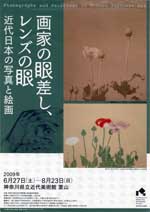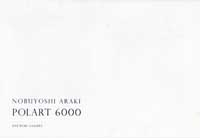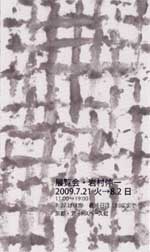 |
Picks is a monthly sampling of Japan's art scene, offering short reviews of exhibitions at museums and galleries in recent weeks, with an emphasis on contemporary art by young artists. |
 |
 |
 |
1 September 2009 |
 |
| 1 | 2 | |
 |
|
 |
 |
 |
|
| Photographs and Paintings in Modern Japanese Art |
| 27 June - 23 August 2009 |
The Museum of Modern Art, Hayama
(Kanagawa) |
 |
| There have been other shows that highlight the links between painting and photography in modern Japan, but this one stands out in its scale -- 215 works -- and range, covering the period from the end of the Shogunate to the 1930s. While the efforts of early Meiji artists like Kakoku Shima, Matsusaburo Yokoyama, Yuichi Takahashi, and Horyu Goseda I and II to develop an amalgam of photographic and painterly expression are intriguing, what catches the eye is the quality of the later art photography of the Taisho and early Showa eras. |
|
|
 |
 |
|
| Naoki Ohji: Ushi Jima / Sotobo |
Ushi Jima:
14 - 27 July 2009
Sotobo:
12 July - 8 August 2009 |
Ushi Jima:
Shinjuku Nikon Salon
Sotobo:
photographers' gallery
(Tokyo) |
 |
| Ohji's photography is in flux: where past series like "XXXX STREET SNAPSHOTS" (2006) and "Cult of Personality" (2007-8) featured typical urban street scenes, these two new shows represent a dramatic broadening of subject matter and mood. His visit to the tiny island of Tairajima, where he shot his Ushi Jima (Island of Cows) series, seems to have been a turning point. Aside from more frequent use of a vertical frame, Ohji's concurrent Sotobo series takes a similar approach, with the fish and fowl portrayed therein assuming a mythological aspect that is oddly unsettling. |
|
|
 |
|
Ayami Ito |
| 13 - 18 July 2009 |
Bangarow
(Osaka) |
 |
| Ito's woodcuts are cute and colorful, but also curious, particularly her recurring rice-ball motifs. The ambiguous imagery is in fact not merely quaint, but fascinating. With her delicate delineation of pleats, wrinkles and lacy patterns, her adroit overlapping and balancing of colors, Ito has created works that demand close and leisurely scrutiny. |
|
|
|
|
|
|
|
 |
|
| Masumi Nakaoka |
| 13 - 25 July 2009 |
O Gallery eyes
(Osaka) |
 |
| In a departure from her past work, Nakaoka here takes a building as her motif. The building is Hiroshima's Atomic Dome, but the artist avers that she was attracted more by the presence of the structure itself than by its historical or symbolic significance. Until now, Nakaoka's paintings were notable for their exquisite equilibrium of motif and empty space and her ability to entice dynamic landscapes from this static imagery. In these new works, the power of the motif tends to limit the play the imagination can bring to the overall landscape. |
|
|
 |
|
 |

 |
|
Nobuyoshi Araki: POLART 6000 |
| 17 July - 20 August 2009 |
Rat Hole Gallery
(Tokyo) |
 |
|
The sheer quantity is overwhelming: 6,000 polaroid prints cover the walls. Viewing the largest surface, with 27x97=2,619 photos, you can't help burst out laughing at its audacity. Araki is nothing if not audacious, as well as showy and playful, and this show may well be his ultimate tour-de-force as Japan's bad boy photographer in residence. Besides his ubiquitous nudes, these snapshots include masses of flowers, food items, and everyday household objects. The effect is one of casual joie de vivre, a shout-out to life and fun.
|
|
 |
 |
|
Shinichi Iwamura |
| 21 July - 2 August 2009 |
Art Space Niji
(Kyoto) |
 |
|
Covering the wall is a lattice painted with earth, beeswax and turpentine. The lines of the grid vary in coloration and texture in a delicate interplay with the bits of mud and dirt that cling to them. Iwamura calls his creations "operations" rather than "paintings," and indeed they appear workmanlike. But it is as if the perpendicular lines extend themselves outward of their own accord, like a framework supporting the placid, unvarying expanse of everyday life.
|
|
|
|
|
|
|
|
|
|
 |
|
 |
|